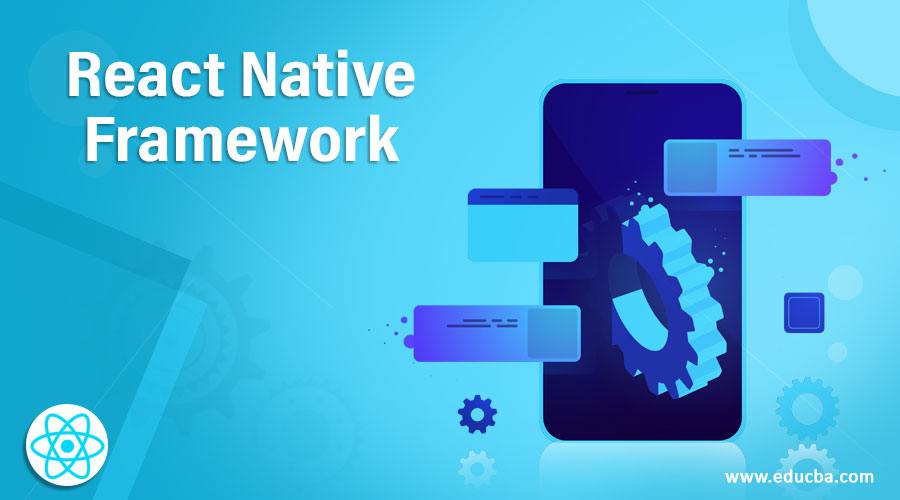Updated May 23, 2023
Introduction to React Native Framework
React Native is a buzzword nowadays in the Developer Community, and the developers are very much excited about it. This technology takes the legacy of React.js, it has everything good about React.js, and it provides an excellent platform for mobile developers to build some awesome, interactive as well as attractive apps. It supports javascript, which makes it much more convenient for Developers. React Native helps the creation of mobile applications for both of the most used platforms, which are iOS and Android. React handles the view controller and generates the native views programmatically using JavaScript.
Explanation to React Native Framework
React Native is a JavaScript Framework that enables App Developers to develop cool apps with multiple components and features on both of the most used Platforms: iOS and Android. React Native makes it comfortable for web developers also to create Native applications using JavaScript, which is their specialty. React Native supports sharing of most of the codes across platforms, which makes it relatively easy to work on iOS and Android Platforms simultaneously, and it acts as an upper hand of React Native over the other Frameworks. React native provides the speed and the power of a native application, and at the same time, it also eases out the process for the Developers using JavaScript. Developers find React Native helpful as it allows them to create and run the entire application logic in JavaScript while maintaining a native user interface. They don’t need to compromise with HTML5 UI.
React Native is similar to React in that it utilizes a combination of JavaScript and JSX (XML-like markup). The way it supports iOS and Android, it has a great future scope and also has the potential to support future platforms as well. Production-ready mobile applications can be easily developed using mobile UI components instead of relying on web views. This approach ensures that the application looks and behaves like a native mobile application. Using separate components, User Interface elements can be built in react-native.
Libraries Used to Create Application Faster
Let us go through some of the libraries which can be used to create the application faster.
- NativeBase: With 12,000 stars on Github, NativeBase is one of the most famous React Native Libraries. NativeBase also supports operating third-party libraries along with it, which suggests that we can create huge projects using the native base and other
- React Native Elements: With 16,000 stars on Github, React native elements is also of one the most used libraries. This library provides a suitable element structure tool instead of making User Interface design easier for the developers. The number of templates in React Native Elements is lesser than NativeBase, but it allows full control of the displayed data. For beginners, React Native Elements can work as a great
- React Native Maps: For integrating maps in our iOS or Android apps, React Native Toolkit can be used. Different customizable cross-platform components are provided to the developers with different map elements for both the
- UI Kitten: With 3800 stars on Github, UI Kitten is a library that has a set of different user interface components. This library helps in combining the design of the elements and using them. Different store styles of all the elements are available in UI Kitten.
- React Native Material UI: React Native Material UI has different UI components that follow Google’s Material Design guidelines. The components are easily customizable, which helps us in combining Material Design according to our requirements. It uses a UI Theme JavaScript
- React Native Fabric: Every application needs analytics; React Native Fabric helps us in combining Fabric Analytics with our cross-platform app. Currently, React native Fabric has 1200 stars on
- Lottie Web: Lottie Web is used to add animations to React Native. Currently, it has over 16,500 stars on GitHub. After Effects, animations can also be rendered on React Native using Lottie Web.
- React Native UI Library: React Native UI library has a toolset of different User interface elements, and it helps developers with components that can support react-native Animatable and React Native blur. It includes shades, fonts, frame borders, and colors which can transform into
- React Native Paper: React Native Paper is a cross-platform library for user interface components. It has an additional plugin known as Babel, which helps in the size reduction of the app. With over 3,400 stars on Github, it is one of the most famous Library of react
- React Native Vector icons: React Native Vector Icons is one of the most useful libraries used for simple and customizable icons. Currently, it has over 11,000 stars on
React Native adds some improvements, which are cross-platform development and developer experience. React Native has all of React.JS’s DOM abstraction, better app performance, and easy-to-understand programming methods for hybrid mobile development.
Conclusion
We understood how a React Developer could efficiently work on React Native with slight advancements. React native Framework is one of the most used Frameworks with the above-discussed benefits. I hope this article has been informative about React Native Framework.
Recommended Articles
We hope that this EDUCBA information on “React Native Framework” was beneficial to you. You can view EDUCBA’s recommended articles for more information.




